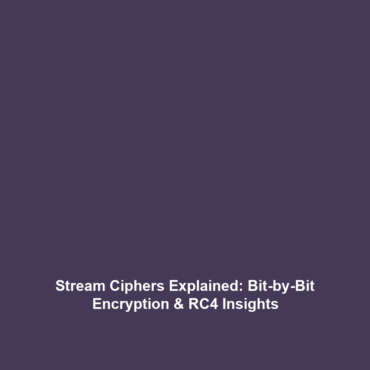Stream Ciphers: Encrypting Data Bit-by-Bit in Cryptography
Introduction
Stream ciphers represent a crucial component of cryptography, particularly in the realm of secure data transmission. By encrypting data bit-by-bit or byte-by-byte, stream ciphers facilitate real-time encryption that is vital for various applications, including secure communications and data protection. One of the most well-known stream ciphers is RC4, which has been widely utilized despite its cryptographic vulnerabilities. Understanding stream ciphers is essential for anyone invested in data security and encryption methods, as they continue to evolve alongside technological advances.
Key Concepts of Stream Ciphers
Stream ciphers operate on a continuous stream of plaintext data, transforming it into ciphertext through a bitwise operation. Below are some key concepts central to stream ciphers:
1. Encryption Process
Stream ciphers encrypt plaintext data one bit at a time. This process means that they require fewer resources than block ciphers, making them ideal for applications where speed is crucial.
2. Key Generation
The security of a stream cipher largely hinges on the strength and randomness of the key used in the encryption process. Robust key generation algorithms can significantly enhance security.
3. Synchronization
Stream ciphers require precise synchronization between the sender and receiver. Any misalignment can lead to decryption errors, which can compromise data integrity.
Applications and Real-World Uses
Stream ciphers are utilized in various real-world scenarios, particularly where encryption is needed in real time. Some key applications include:
- Wireless Communication: Stream ciphers are employed in securing data transmitted over wireless networks for mobile devices.
- Video Streaming: They enable secure video transmissions by encrypting data as it is sent, minimizing latency.
- Instant Messaging: Many instant messaging platforms use stream ciphers to encrypt chats, protecting user privacy.
Understanding how stream ciphers are used in cryptography is essential for anyone involved in digital communications.
Current Challenges of Stream Ciphers
While stream ciphers like RC4 have their advantages, there are prominent challenges involved in their study and application:
- Security Vulnerabilities: Some stream ciphers, particularly RC4, are known to have significant security vulnerabilities that make them less reliable.
- Key Management: Ensuring secure key management can be intricate, especially in systems that require frequent key changes.
- Synchronization Issues: Maintaining accurate synchronization is a continuous challenge that can lead to data corruption.
Future Research and Innovations
As the field of cryptography evolves, numerous innovations and research directions are emerging for stream ciphers:
- Post-Quantum Cryptography: Research is focusing on developing stream ciphers that can withstand potential quantum computing attacks.
- New Algorithms: Efforts are underway to create new stream cipher algorithms that offer enhanced security while maintaining speed.
- Integration with AI: Future innovations may involve integrating artificial intelligence to improve key generation and management processes.
Conclusion
Stream ciphers remain an integral part of cryptography, offering unique advantages for real-time data encryption. However, the challenges that exist, including vulnerabilities and synchronization issues, necessitate ongoing research and development. As we advance, the future of stream ciphers promises significant innovations that could redefine secure communications. For more insights into cryptographic methods, consider exploring block ciphers or encryption algorithms.

